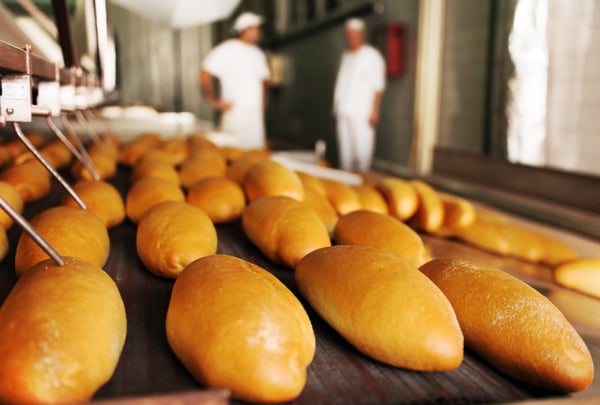How Robots With Vacuum Grippers Improve Food Safety

Posted on Apr 04, 2019 in Robot Grippers
6 min read time
2018 was the "year of food-borne illnesses." Could robots could be the solution? You know, robot safety means more than just having a safe robot! With the right end effector, robots can even improve food safety. Here's why vacuum grippers are one of the most food-safe end effectors available.

According to a recent article by RoboGlobal, 2018 was the "year for food-borne illness." Doesn't sound good, right? However, it's not as bad as it sounds. One reason for last year's increase in food safety issues was due to improved detection technologies, which can only be a good thing. Even so, the RoboGlobal article argues that many food-safety issues could be reduced — or even eliminated — by using more robots in food manufacturing.
We've written before about the huge impact that robotics is having on the food industry's productivity, all the way from food manufacture to food packaging. We've also written quite a lot about robot safety (i.e. making robots that are safe). But, we haven't really discussed the impact of robots on food safety.
A hugely important factor for food safety is the end effector. Vacuum grippers are one of the most popular solutions for food safe robots.
Read more:
What is a vacuum gripper?
Vacuum grippers (or vacuum cups) use pneumatics to pick up objects. This distinguishes them from grippers like our 2F Gripper range which pinch or grasp objects between mechanical fingertips.
The basic operation of a vacuum gripper is this:
- A flexible suction cup, usually made from a plastic, is touched onto the surface of the food.
- A pneumatic valve is activated which sucks air out of the suction cup. This pulls the surface of the food onto the cup.
- With the food firmly attached to the suction cup, the robot moves to its next position.
- When in place, the pneumatic valve either stops the flow of air — which stops the vacuum — or reverses the flow of air — which blows the food away from the suction cup.
There are various types of vacuum gripper (e.g. bellows, suction pads). The differences between them are usually in the size and shape of the suction cup itself, which can vary wildly.
It is this variety of cup sizes that makes vacuum grippers well suited to handling foodstuffs. Tiny suction cups can be used to pick up, say, a single chocolate. At the other end of the scale, some vacuum grippers contain many, large suction cups and can lift entire cases of packaged food for a palletizing task.
What makes vacuum grippers food safe?
First, it's important to say that not all robotic systems with vacuum grippers are food safe. Both the robot and the gripper need to be washable and made of materials which are food safe. The last thing you want is for the robot itself to contaminate the food.
Having said that, robots are a great way to ensure the safety in food production. As one journalist remarked "[Robots] don’t have to be reminded to wash their hands, or cover their mouths." Food safety issues often occur because human workers contaminate the food, for example, when they cough when they are ill. If you saw a robot coughing, you'd be very worried!
Vacuum grippers are particularly well-suited to handling food. Here are 3 properties that make them food-safe:
- Little contact with the food — Unlike with some mechanical grippers, there is little contact between the gripper and the food. The only things that touche the food are the plastic edge of the suction cup and air.
- Easy to clean — It is easy to blow particles (e.g. crumbs, bits of food) from a vacuum gripper simply by reversing the flow of air. Many are also "wash-down" compatible, which is perfect if your robot is also able to be washed down.
- Easy to replace suction cup — As the only part of the gripper that touches the food, it's important that the suction cup can be replaced when it gets old to avoid contamination. This is the case with many vacuum grippers.
The pros and cons of using vacuum grippers for food
Are vacuum grippers really better than mechanical grippers for food production? Not necessarily.
Mechanical grippers outperform vacuum grippers in some situations.
There are a few disadvantages to using vacuum grippers:
- Sensitive to dust — If you want to pick up a cake which has been dusted in icing sugar, forget about it. Vacuum grippers are sensitive to dust. This issue can be partially overcome by selecting a gripper which is designed to handle dusty objects.
- Requires compressed air — Fingered grippers do not always require any extra power source. However, vacuum grippers do need a source of pressurized air. This means installing extra technology.
- Surface texture affects performance — Vacuum grippers are most effective with smooth surfaces. Bumpy, textured surfaces can mean that they never create a strong enough vacuum to lift the object. There are ways around this (e.g. changing the suction cup size) but it does mean you need to be aware of the surface texture.
- Can leave marks — Suction cups can leave a ring on the surface of some foods, which might not be acceptable. You can reduce the strength of the suction to overcome this, but then the suction force might not be enough to pick up the food item.
However, despite these disadvantages there are some clear advantages to using vacuum grippers in food production:
- Flexible — Many foodstuffs are not a uniform size and shape, e.g. two apples are never exactly alike. Vacuum grippers can easily handle varied shapes and sizes. You can even use the same vacuum gripper to handle completely different foodstuffs.
- Robust to inaccurate positioning — Unlike with fingered grippers, you don't need to precisely place the gripper to pick up the food item. You just need to touch its surface.
- Gentle — The force applied by a vacuum gripper can be very gentle, which makes it good for handling delicate foodstuffs.
- Good for broad materials — Vacuum grippers are most effective when the object is broad compared to the suction cup. This is often the case with the high-speed food-picking robots of which there are many videos online.
What foods can a vacuum gripper pick up?
Vacuum grippers can be used to pick up any food item that you can think of!
Don't believe me? Here's a video of a vacuum gripper being used to make a sandwich. It picks up the bread, cucumber, meat, and tomato, with no problems at all.
Okay, I'll admit it, I can think of at least one food item that a vacuum gripper couldn't pick up: liquid soup...
... Let's say almost any food item you can think of!
How could a vacuum gripper be useful for your robot application? Tell us in the comments below or join the discussion on LinkedIn, Twitter, Facebook or the DoF professional robotics community.


.jpg)





Leave a comment